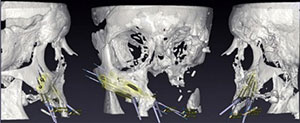The newly released, 
Bioprinted live cells in hydrogel after seven days

The newly released, 
Bioprinted live cells in hydrogel after seven days
BioBots launched a selective Beta program 
Starting with its beta community earlier this year, the company aims to pair its accessible technology model with a growing global network of researchers and clinicians to foster an open dialog around tissue engineering research and development. “Our incredible team at BioBots is driven by the mission of engineering biology,” Cabrera said. “To build the BioBot 1, we partnered with some of the most brilliant minds in tissue engineering, and together we’ve developed the world’s most accessible biofabrication technology. This is one of many steps that we’re taking towards democratizing the ability to build with life, and the ramifications are game changing. With the BioBot 1 comes the ability to build 3D living tissues that can be used to reduce the time and cost of developing new drugs, 3D living tissues that can be used to personalize therapies, 3D living tissues that can be implanted into patients and 3D living tissues that can be studied to explore the largest mystery of our generation – life. We can’t wait to see what else people will build now that a BioBot will sit on every lab bench around the world.”
While still a young technology, bioprinting devices like the BioBot 1 have the potential to greatly aid researchers in understanding the progression of cancer and other pathologies, with the ability to replicate and study biological structures built out of a patient’s own cells. Bioprinting can significantly reduce the length of drug testing cycles, and even enable patient-personalized treatment programs for complex diseases for the first time in medical history. While simple bioprinted tissues and organs have already seen transplantation in patients, the historically limited access to these devices has restricted innovation to large, well-funded institutions with large teams of highly specialized researchers. Greater access to this technology through easy to use desktop models like BioBot 1, and the collaborative community around bioprinting research that BioBots has created, will only accelerate this development.
“We have spent the last year listening to our community and painstakingly deciding what features were most important to making the next generation of living tissues in the lab,” added Biobots CoFounder and CTO, Ricky Solorzano. “The result is the best 3D bioprinter in the world – the BioBot 1. We have hit a perfect balance between versatility and accessibility. While being a very open system to allow users to input a wide range of materials and cell types, it still remains extremely easy to use. We are further releasing the most widely used bioink in the field today, BioGel, a gelatin methacrylate based solution, to easily allow labs to begin bioprinting with a matrix that is well characterized and tested. We are extremely excited to see what you will build.”
If the research innovation explosion that the BioBots team is expecting will follow along the lines of regular 3D printing technology, we are in for yet another roller coaster ride of inventions and new ideas. That’s how the 3D printing industry works, in all its forms and applications, even the most amazing ones.
